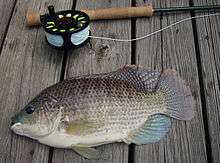Oreochromis aureus
| Oreochromis aureus | |
|---|---|
 | |
| Scientific classification | |
| Kingdom: | Animalia |
| Phylum: | Chordata |
| Class: | Actinopterygii |
| Order: | Perciformes |
| Family: | Cichlidae |
| Subfamily: | Pseudocrenilabrinae |
| Tribe: | Tilapiini |
| Genus: | Oreochromis |
| Species: | O. aureus |
| Binomial name | |
| Oreochromis aureus (Steindachner, 1864) | |
| Synonyms | |
| |
The blue tilapia[1] or Israeli tilapia, Oreochromis aureus, is a species of fish in the Cichlidae family. Native to Northern and Western Africa, and the Middle East, through introductions it is now also established elsewhere, including parts of the United States, where it has been declared an invasive species and has caused significant environmental damage.[2] It is known as blue kurper in South Africa.[3]
Description
The blue tilapia is a freshwater fish with a high tolerance for brackish water. Adults are usually 5 to 8 in (13 to 20 cm) in length[2] and weigh 5 to 6 lb (2.3 to 2.7 kg);[4] the largest recorded specimen was more than 21 inches (53 cm) long and weighed more than 10 pounds (4.5 kg).[4] Blue tilapia are mouthbrooders, and broods range from 160 to 1600 eggs per female.[2] O. aureus is primarily herbivorous, but will occasionally consume zooplankton;[2] the young include small invertebrates in their diet. [1]
Range
The blue tilapia is native to Northern and Western Africa, and the Middle East, from the Senegal, Niger, Benue and lower Nile Rivers in Africa to the Jordan River in the Middle East.[1] Through introductions, the fish can be found in the United States in Texas, Alabama, Florida, and Nevada. It has also been established in Central and South America, and Southeast Asia.[1] The original stocks of O. aureus in the United States were from Israel.[5]
Israel
The Israeli Oreochromis aureus is known there also as "Jordan St. Peter's fish" and was traditionally coming down the Jordan River from Lake Huleh to the Sea of Galilee.[6] It is black and larger than the white "Common St. Peter's fish" or simply "St. Peter's fish" (Tilapia zillii, musht in Arabic and adopted into Modern Hebrew, lit. "comb"). Another "St. Peter's fish" is the "Galilee St. Peter's fish" (Mango tilapia, Sarotherodon galileus; Arabic musht 'abyad), which is white and also larger than Tilapia zillii.[6]
Invasive species
Oreochromis aureus has been introduced in many places around the world for use as a food fish, and frequently in order to control aquatic vegetation.[7] Its presence may have in many cases been mis-documented as Oreochromis niloticus, because the two species were only recently distinguished.[7]
In the United States
Since its introduction into Florida in 1961,[4] the fish has increased its range and frequency of occurrence. It is now the most widespread foreign species in Florida, with established populations as far north as Lake Alice, in Gainesville.[5] It is a major management problem for the National Park Service due to its predominance in Taylor Slough in Everglades National Park, where it has changed the fish community structure.[5] The species is also expanding its range in Texas. It was at one time responsible for inhibition of the population of largemouth bass in Lake Trinidad (in Henderson county) until it was extirpated, and is implicated in the unionid mussel declines in two bodies of water in Texas.[5] It is also blamed for a severe decline in native fish populations in Warm Springs Natural Area, Nevada.[5]
See also
References
- 1 2 3 4 "Oreochromis aureus". FishBase. Retrieved 2008-06-29.
- 1 2 3 4 "Fact Sheet for Oreochromis aureus (Steindachner, 1864)". Gulf States Marine Fisheries Commission. Retrieved 2008-06-28.
- ↑ "Blue Kurper". Flyloops. Retrieved 2012-03-22.
- 1 2 3 "Florida's Exotic Freshwater Fishes". State of Florida, Division of Freshwater Fisheries. Retrieved 2008-06-29.
- 1 2 3 4 5 "NAS Species Fact Sheet". US Geological Survey. Retrieved 2008-06-30.
- 1 2 Aharon Geva-Kleinberger, Autochthonous Texts in the Arabic Dialect of the Jews of Tiberias, Otto Harrassowitz, Wiesbanden 2009, volume 046, pp. 67 and 107, ISBN 978-3-447-05934-3
- 1 2 "Global Invasive Species Database". Retrieved 31 July 2014.